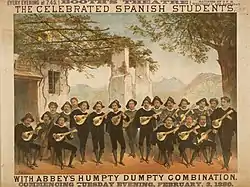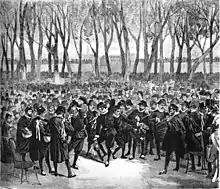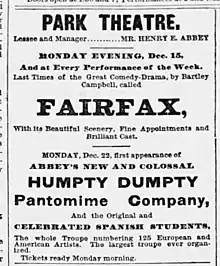Spanish Students
The Spanish Students was a musical group from Madrid which popularized the tuna form of traditional student bands (Spanish: estudiantina). It gained international recognition after performing at the Carnival of Paris and the Paris Exposition of 1878.[1] Under the name Estudiantina Española Fígaro, members of the original group toured France, Germany, Russia, Italy, Holland and England.[1] After two years touring Europe, some members also toured North and South America in 1880.
The Spanish Students
| |
|---|---|
 Poster for a performance of The Spanish Students in Manhattan, New York, 1880. | |
| Background information | |
| Origin | Madrid, Spain |
| Genres | Spanish folk, classical |
| Instruments | bandurria, guitar, violin, cello |
The original group was founded by Ildefonso de Zabaleta in 1878. The group inspired many imitators, some of whom performed under the name Spanish Students or Española Fígaro, and some of the original 64 may have been in these groups. The Figaro Spanish Students led by Dionisio Granados helped lead to the popularization of the mandolin in Europe and America, and the formation of mandolin orchestras.
Formation and European tour

The original Estudiantes Española or Estudiantina Española was a group of 64 students formed by 26 February 1878, principally from Madrid colleges.[2] They dressed in historical clothing, representing ancient sophists of Salamanca and Alcala and traveled to Paris for Carnival staying from March 2 through March 15.[2] This early group of students played flutes, guitars violins, bandurrias, flutes and tambourines.[2] This early group was led by Ildefonso de Zabaleta (president) and Joaquin de Castañeda (vice president).[2] The group performed before large audiences in Paris (reports of 10,000 and 56,000 people showing up for a night's entertainment were reported).[2]
Their success in Paris preceded a second group of Spanish performers, known as the Esudiantina Figaro or Esudiantina Española Figaroa (Figaro Band of Spanish Students).[3] This group was founded by Dionisio Granados and toured Europe dancing and playing guitars, violins and the bandurria, which became confused with the mandolin.[4][5][6] They performed in France, Germany, Russia, Italy, Holland and England..[1]
US tour

The Spanish Students were brought to the United States by Henry Eugene Abbey in January 1880, performing with his Humpty Dumpty Pantomime Company.[7] They performed first in Boston[1] then at Booth's Theatre in Manhattan.[8] Their US touring group consisted of 20 men (15 musicians and 5 servants).[1] Four or five played guitars, one played the cello, and the leader played the violin. The other nine played bandurrias, which US newspapers referred to as mandolins or Spanish mandolins.
Influence
The Spanish Students created a sensation at the Paris Exposition, and popularized the tuna form of student performing groups.[4] Their success spawned other groups who imitated their musical style and costumes.[7]
Among the imitators were a wave of Italian mandolinists who toured Europe in the 1880s and 1890s, and the United States by the mid-1880s, playing and teaching their instrument.[9] Thousands of young men and women took up the instrument as a pastime, and it became a symbol of society.[10] The popularity of the mandolin reached its height just after the turn of the century.[10] Mandolin orchestras were formed worldwide, incorporating the mandolin family of instruments and also guitars, double basses, and zithers.
The mandolin's popularity in the US was spurred by the success of the Spanish Students.[11] An Italian musician, Carlo Curti, hastily started a musical ensemble after seeing them perform; his group of Italian-born Americans called themselves the "Original Spanish Students", anticipating that the American public could not tell the difference between the Spanish bandurrias and Italian mandolins.[7][12] The imitators' use of mandolins helped to generate enormous public interest in an instrument that had been relatively unknown in the US.[13][7]
Members
It is difficult to ascertain the membership of the original group, as the name of the group has been used by many impostors (such as Carlo Curti), as well as splinter groups in which some of the members performed separately. The lists below are from specific tours or performances.
1880 United States
After touring for almost two years in Europe, this group of the students came to the United States, touring well into 1881. Those arranging the US tour expected 22 musicians, but only these 15 were confirmed to have arrived at the port. News accounts of the performances report a group of consistent size. When reports mention the number of instruments, the number of guitars (either five or six) and mention of the violin or cello (or the base viola) varies.
- Ygnacio Martin,[1] violin
- Gavino Lapuente,[1] (president 1882)
- Valentin Caro,[1] bandurria (1882)
- José Rodriguez,[1] guitar
- José Garcia,[1] bandurria (1882)
- José Fernandez,[1] bandurria (1882)
- Melquiadez Hernandez[1]
- Enrique Olibares,[1] bandurria (1882)
- Antonio Carmona,[1] bandurria (1882)
- Manuel Gonzalez,[1] bandurria (1882)
- Miguel Justos,[1] guitar
- Miguel Loper,[1] guitar (1882)
- Eugenio Anton,[1] guitar (1882)
- Juan Ripoll,[1] violin (1882)
- Laureano Hernandez,[1] guitar (1882)
Footnotes
- "Life in the Metropolis, Dashes Here and There by the Sun's Reporters, Spanish Students as Musicians—Their Arrival in America after Successful Performances in Europe—First Appearing in Boston". The Sun. New York, New York. 2 January 1880. Retrieved 3 October 2016.
- Martín Sárraga, Félix O. (2016). "Crónica del viaje de la Estudiantina Española al Carnaval de París de 1878 según la prensa de la época". Tvnae Mvndi. academia.edu. 2: 7, 8, 14, 16, 39, 44, 46, 47. Retrieved 9 October 2016.
- Martin Sárraga, Felix O. (26 July 2015). "Apuntes sobre las giras europeas de la Estudiantina Fígaro". tunaemundi.com. Retrieved 10 October 2016.
Para comprender mejor el surgimiento de la Estudiantina Española Fígaro hemos necesariamente de recordar que muy posiblemente no hubiera existido si antes no se hubiera producido la creación de la Estudiantina Española con el fin de asistir al Carnaval de París de 1878... We say that the Spanish Estudiantina Figaro quite possibly would not exist if there were not produced before the creation and media coverage of the Spanish Estudiantina.[translation]: To better understand the emergence of the Spanish Estudiantina Figaro we have necessarily to remember that they most likely would not have existed had there not previously the Spanish Estudiantina been created in order to attend the Paris Carnival 1878... We say that the Spanish Estudiantina Figaro quite possibly would not exist if there were not produced before the creation and media coverage of the Spanish Estudiantina.
- Sparks 2003, p. 20–29
- Martin Sárraga, Felix O. (26 July 2015). "Análisis comparado de los integrantes de la Estudiantina Española Fígaro (1880 -1889". tunaemundi.com. Retrieved 10 October 2016.
Sabemos por diversas fuentes que la Fígaro fue fundada por Dionisio Granados... [Translation]: We know from various sources that Figaro was founded by Dionisio Granados...
- Martin Sárraga, Felix O. (26 July 2015). "Apuntes de la gira por la Península Ibérica de la Estudiantina Fígaro (1881 - 1890)". tunaemundi.com. Retrieved 10 October 2016.
La Estudiantina Española Fígaro, como publicara la prensa de 1882, "es una asociación de jóvenes profesores, músicos ..... se creó y constituyó en Madrid formando una magnífica banda de guitarras, bandurrias y violines que partió de allí en 1878 con el objeto de dar conciertos [Translation]: The Spanish Estudiantina Figaro, as published Press 1882, "is an association of young teachers, musicians ..... was created and established in Madrid forming a magnificent band of guitars, bandurrias and violins left there in 1878 with the concerts object
- Sparks 2003, p. 26–27
- "Death of Henry E. Abbey; The Well-Known Manager's Long Career Closed". The New York Times. October 18, 1896. Retrieved March 25, 2015. Column 3
- Sparks 2003, p. 22–135
- Sparks 2003, p. 96
- Sparks 2003, p. 23–29
- Leonard Wyeth (2008). "1880 Estudiantina Figaro and the Mandolin Orchestra". Acoustic Music .org. Archived from the original on 17 October 2008.
- Jean Dickson, University at Buffalo (SUNY) (2006). "Mandolin Mania in Buffalo's Italian Community, 1895 to 1918" (PDF). Journal of World Anthropology: Occasional Papers. II (2): 1–15.
- "The Wearers of the Ivory Spoon". Sterling Standard. Sterling, Illinois. 31 January 1883. p. 1. Retrieved 3 October 2016.
General references
- Tyler, James; Sparks, Paul (1996). "The Mandolin: Its Structure and Performance (Sixteenth to Twentieth Centuries)". Performance Practice Review. 9 (2).
External links
- Postcard showing portraits of the 1880 group that came to the United States.
- Chronicle of the Spanish Estudiantina trip to Paris Carnival 1878 according to the press of the time
- Comparative analysis of the members of the Spanish Estudiantina Figaro (1880–1889)
- Notes on the European tours of the Estudiantina Figaro
- The Figaro Estudiantina traveled most in the 19th century
- Notes from the tour of the Iberian Peninsula of the Estudiantina Figaro (1881–1890)